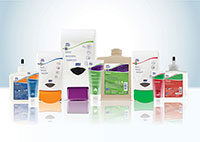Hand protection: Are gloves enough?

Responding is Andreas Klotz, technical product manager, Deb Group, Charlotte, NC.
Do you know that skin disorders occur far more often than any other work-related health issue? Workers’ hands often experience redness, irritation or cracks – all symptoms of an occupational skin disease. The Centers for Disease Control and Prevention estimates that more than 13 million workers in the United States are potentially exposed to chemicals that can be absorbed through the skin, and one out of 1,000 workers will report a work-related skin disease per year in Western industrialized countries.
Personal protective equipment, such as gloves, often is used to protect workers from exposure to hazardous chemicals or harmful microorganisms. However, failure to ensure gloves are in good condition, or to exchange gloves at proper frequency, can be damaging to skin as well. By taking the right preventive steps to minimize contact with damaging agents and adopting an appropriate skin safety regimen, the risk of occupational dermatitis can be reduced. It’s not enough to provide workers with protective gloves. Skin care is essential to maintain healthy skin and reduce the risk of occupational skin diseases.
Gloves won’t always cover it
Gloves are an important measure in preventing exposure to hazardous substances. But they should not be worn longer than necessary. If your workers wear gloves often and for long periods of time, they likely understand how wearing gloves can change their skin’s condition. The skin often gets wrinkly, soft and dry. Additionally, the moisture in the glove may harbor bacteria. Some people experience fungal infections similar to athlete’s foot on the hands when wearing gloves for long durations.
Studies indicate that wearing gloves will contribute to skin problems when other skin-stressing factors, such as frequent handwashing or contact with irritants, are involved. Under most use conditions, wearing gloves can exacerbate stress to the skin and contribute to work-related dermatitis.
Don’t skip skin care
Dermatitis can become a financial burden for the employee as well as for the employer. According to the Bureau of Labor Statistics, dermatitis is responsible for 50 percent of all industrial illnesses that result in lost work time. Just one case of occupational dermatitis costs employers approximately $3,500 in workers’ compensation claims and results in an average disability of 23.9 days, according to a study published in the Journal of the American Medical Association.
It is far easier to prevent dermatitis than to cure it. Addressing and reducing occupational skin disease requires an integrated skin care approach to protect, cleanse and condition the skin. This is achieved with a daily routine of using essential skin care products consisting of:
- Protectant creams applied before working to reduce contact with contaminants and ultraviolet rays, and to make cleansing quicker and easier.
- Appropriate hand cleansers used as soon as possible after hands become contaminated during work.
- Restorative creams for application after working to moisturize, nourish or condition work-stressed skin.
Skin care protects workers’ hands
When creams are not used, skin can become dry, cracked and unhealthy, which increases the risk of skin disease. Creams can also help to make the skin easier to clean. Protectant creams are specially formulated for specific applications to leave a protective layer on the surface of the skin.
Meanwhile, restore creams improve skin strength by moisturizing, nourishing and conditioning. Adopting a skin care program that includes protect-and-restore creams is essential to maintaining healthy skin and reducing the risk of occupational skin diseases.
A tailored skin care program encourages skin care best practice and sustainable behavior to bring real benefits to an organization. Employers are at risk for increased costs due to employee sick days and reduced productivity. The risk of failing to address occupational skin diseases is great, and any investment made in effective skin care flows back to the bottom line many times over.
Post a comment to this article
Safety+Health welcomes comments that promote respectful dialogue. Please stay on topic. Comments that contain personal attacks, profanity or abusive language – or those aggressively promoting products or services – will be removed. We reserve the right to determine which comments violate our comment policy. (Anonymous comments are welcome; merely skip the “name” field in the comment box. An email address is required but will not be included with your comment.)

